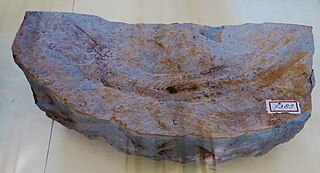
Echidnocephalus troscheli is an extinct, prehistoric halosaur. Fossils are found from Campanian strata of Westphalia, Germany. The complete and incomplete fossil specimens that have been found suggest an animal already looking very much like modern halosaurs.
Elopopsis is an extinct genus of prehistoric bony fish that lived from the Cenomanian to Campanian.
Salminops is an extinct genus of prehistoric bony fish that lived during the Cenomanian known from USA and Portugal.

Eubiodectes is an extinct genus of prehistoric bony fish that lived during the Cenomanian.
Enischorhynchus is an extinct genus of prehistoric bony fish that lived during the Turonian of southern Texas.
Oligopleurus is an extinct genus of prehistoric bony fish that lived during the Kimmeridgian stage of the Late Jurassic epoch.
Inichthys is an extinct genus of prehistoric marine bony fish that lived during the Lopingian epoch. Fossils were recovered in the Kuznetsk Basin, European Russia.

Mesolepis is an extinct genus of prehistoric bony fish that lived during the Tournaisian stage of the Mississippian epoch.
Pholidophoretes is an extinct genus of prehistoric ray-finned fish that lived during the Carnian stage of the Late Triassic epoch.
Elpistoichthys is an extinct genus of prehistoric bony fish that lived during the Carnian stage of the Late Triassic epoch.
Illiniichthys is an extinct genus of prehistoric bony fish that lived during the late Moscovian stage of the Pennsylvanian epoch in what is now Illinois, United States. Fossils were collected from the Mazon Creek fossil beds. The genus is named after the Illini Native American tribe.
Nozamichthys is an extinct genus of prehistoric bony fish that lived during the late Moscovian stage of the Pennsylvanian epoch in what is now Illinois, United States. Fossils were collected from the Mazon Creek fossil beds. The first part of the genus name is Mazon spelled backwards, and the second part means 'fish'.
Sundayichthys is an extinct genus of prehistoric bony fish that lived during the Carboniferous period in what is now South Africa. Fossils were recovered from the Upper Witteberg Series.
Egertonia is an extinct genus of prehistoric bony fish. The earliest occurrences of the genus in the fossil record are from the Late Cretaceous of Madagascar and India.

Ionoscopus is an extinct genus of prehistoric ray-finned fish.

Notelops is an extinct genus of prehistoric ray-finned fish.
Manlietta is an extinct genus of prehistoric ray-finned fish.
Pholidoctenus is an extinct genus of prehistoric ray-finned fish.
Pholidolepis is an extinct genus of prehistoric ray-finned fish.
Pholidophoroides is an extinct genus of prehistoric ray-finned fish.




